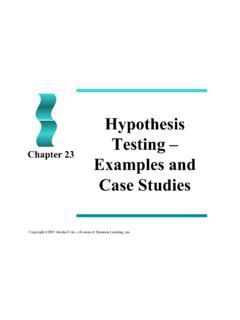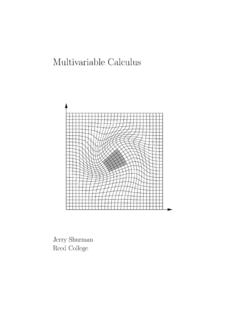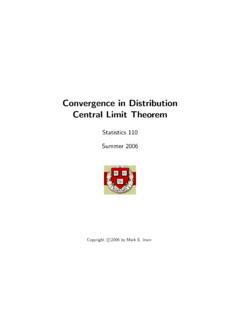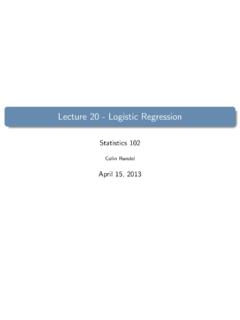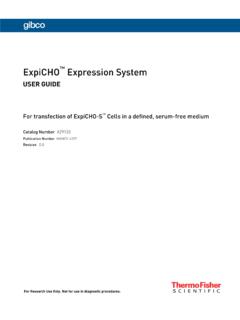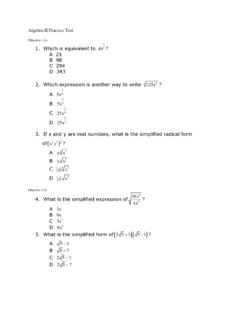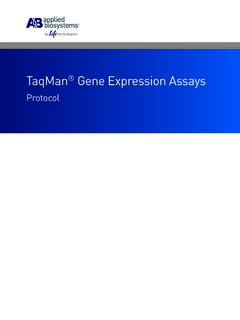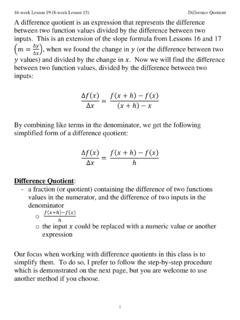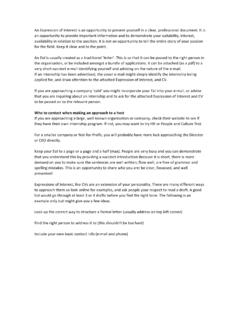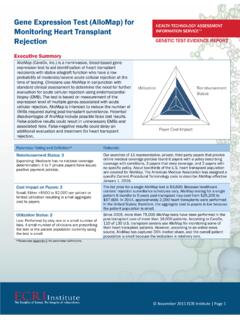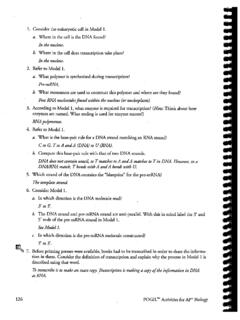Transcription of GENE EXPRESSION - Duke University
1 113 GENE EXPRESSION The process of gene EXPRESSION simply refers to the events that transfer the information content of the gene into the production of a functional product, usually a protein. Although there are genes whose functional product is an RNA, including the genes encoding the ribosomal RNAs as well as the transfer RNAs and certain other small RNAs, the vast majority of genes within the cell are protein-encoding genes. As shown in the figure above, the EXPRESSION of a eukaryotic gene is a complex process involving a variety of steps prior to the actual synthesis of a protein. These include the transcription of the gene into the primary RNA product, processing of this initial gene transcript to remove intron sequences and create the mature 3' terminus, transport of the processed mRNA transcript to the cytoplasm, and then finally, translation of the messenger RNA into protein.
2 With very few exceptions, all of the genes that encode proteins follow this pathway. This complexity is in sharp contrast to the relatively simple process of gene EXPRESSION in prokaryotic cells where the product of the gene is the mRNA and there is no nucleus that separates the genetic material from the machinery necessary to synthesize proteins. 114 Thus, in a bacterium, protein synthesis actually begins on a nascent RNA molecule, well before the synthesis of the RNA is complete. Transcription The initial step in gene EXPRESSION is the transcription of the DNA molecule into an exact RNA copy. As already discussed, the basic unit of heredity, the gene, is a double stranded DNA molecule and the information in the gene is encoded in the sequence of nucleotides.
3 The transfer of information, to the ultimate synthesis of a protein, is accomplished via an RNA intermediate, the so-called messenger RNA. The mRNA molecule contains the exact same sequence of nucleotides as found in the DNA molecule (with U substituted for T). This occurs through the process known as transcription and is carried out by an enzyme termed DNA-dependent RNA polymerase. The product of transcription is an RNA molecule that is identical in sequence content to one of the DNA strands (the sense strand) and complementary to the other DNA strand (the template strand). RNA differs from DNA in two respects. First, RNA contains a hydroxyl (OH) residue at the 2' position of the sugar moiety (ribose) whereas DNA contains an H at this position (deoxyribose).
4 This changes some of the chemical properties of the two molecules. Second, RNA replaces the base thymine with uracil. Although they are chemically different, their base pairing properties (complementarity to adenosine) are the same. Thus, in DNA, A pairs with T whereas in RNA, A pairs with U. Transcription always proceeds in a 5' to 3' direction with respect to polarity of the nucleotides in the RNA. Thus, an unmodified primary transcription product would contain a 5' end with a triphosphate and a 3' end with a OH. There are actually three distinct forms of RNA polymerase found in eukaryotic cells that are responsible for the transcription of three distinct types of genes: the genes encoding the ribosomal RNAs are transcribed by RNA polymerase I; the protein-encoding genes that produce 115 the messenger RNAs are transcribed by RNA polymerase II; finally, the genes encoding transfer RNAs as well as certain other small RNA molecules are transcribed by RNA polymerase III.
5 Transcription involves three distinct steps. First, there must be a recognition of the gene by the RNA polymerase. This is accomplished via the interaction of a variety of proteins called transcription factors that provide the recognition step, guiding the polymerase to the correct site. Moreover, the interaction of these transcription factors with their DNA recognition sequences represents a rate-limiting step in the process of transcription initiation. Sequences in the DNA which are recognized by these transcription factors, and which serve as binding sites for the transcription factors, are generally upstream (5') of the start site for transcription and are called promoters. Additional transcription factors can bind to sequence elements called enhancers that may be located further upstream or even downstream of the gene.
6 In either case, the DNA sequences that bind the transcription factors must be located on the same DNA molecule, thus the same chromosome, as the gene which is regulated. As such, these sequences are said to act in cis. The promoter is absolutely essential for transcription whereas the enhancer, as its name implies, increases the efficiency of transcription. A critical component of many promoters is the sequence element TATA which is located nearest to the site of transcription initiation (about 30 nucleotides away). The TATA element binds a general transcription factor known as TBP (TATA-binding protein) which is a component of a larger complex known as TFIID. 116 Second, the polymerase must initiate transcription.
7 This does not involve a primer molecule as is the case for DNA synthesis but rather starts de novo at a specific site in the gene. This site is dictated as a result of the interaction of the RNA polymerase at a specific site, guided by the transcription factors that have bound to the promoter and enhancer sequences. Third, the polymerase must complete the transcription of the gene and then terminate transcription. In some cases, the termination of transcription is precise whereas in other cases it can occur heterogeneously over a broad region of DNA. It is also true that transcription can terminate prematurely, prior to the complete synthesis of the RNA transcript, thus precluding the formation of a functional RNA molecule, and therefore serving as a mechanism to regulate transcription.
8 Cis-Acting Elements: As discussed previously, transcription is governed by DNA sequences usually located upstream (5') of the coding sequences. These are binding sites for proteins that stimulate transcription by allowing RNA polymerase to interact. They must be physically linked to the gene in order to have an effect and thus are said to function in cis. Trans-Acting Transcription Factors: These are the proteins that recognize and bind to the cis-acting promoter and enhancer elements. There are usually multiple cis-acting elements, and thus multiple trans-acting factors, that are essential for transcription of a given gene. The binding of factors to these elements facilitates the interaction of RNA polymerase and thus the initiation of transcription.
9 Thus, transcription initiation can be regulated by controlling the activity or the presence of these trans-acting factors. Transcription factors possess two essential properties - the ability to bind to DNA in a sequence specific manner and the ability to cause a stimulation of transcription. Generally, these two properties are a function of distinct and separable domains in the proteins. That is, one can often identify and define a domain of the protein, the transcription factor, that is essential for DNA binding and a separate, distinct domain of the protein that functions to activate transcription once bound to the DNA. The DNA binding domain is responsible for recognition and interaction with a specific linear DNA sequence in the enhancer or promoter.
10 Typically, this involves a 4 to 8 nucleotide recognition sequence in the DNA. Although the interaction of the protein with the DNA is specific and can be detected by a variety of methods, it generally is a weak interaction that will readily dissociate. The capacity to stabilize this otherwise weak interaction is likely a critical aspect of transcription control whereby multiple factors must interact on the DNA to stabilize a functional complex. The domain of the transcription factors that is essential for transcription activation mediates protein-protein interactions with other components of the 117 transcription machinery. In particular, activation domains are often responsible for interaction with components of the basal transcription complex that includes the TFIID factor.



